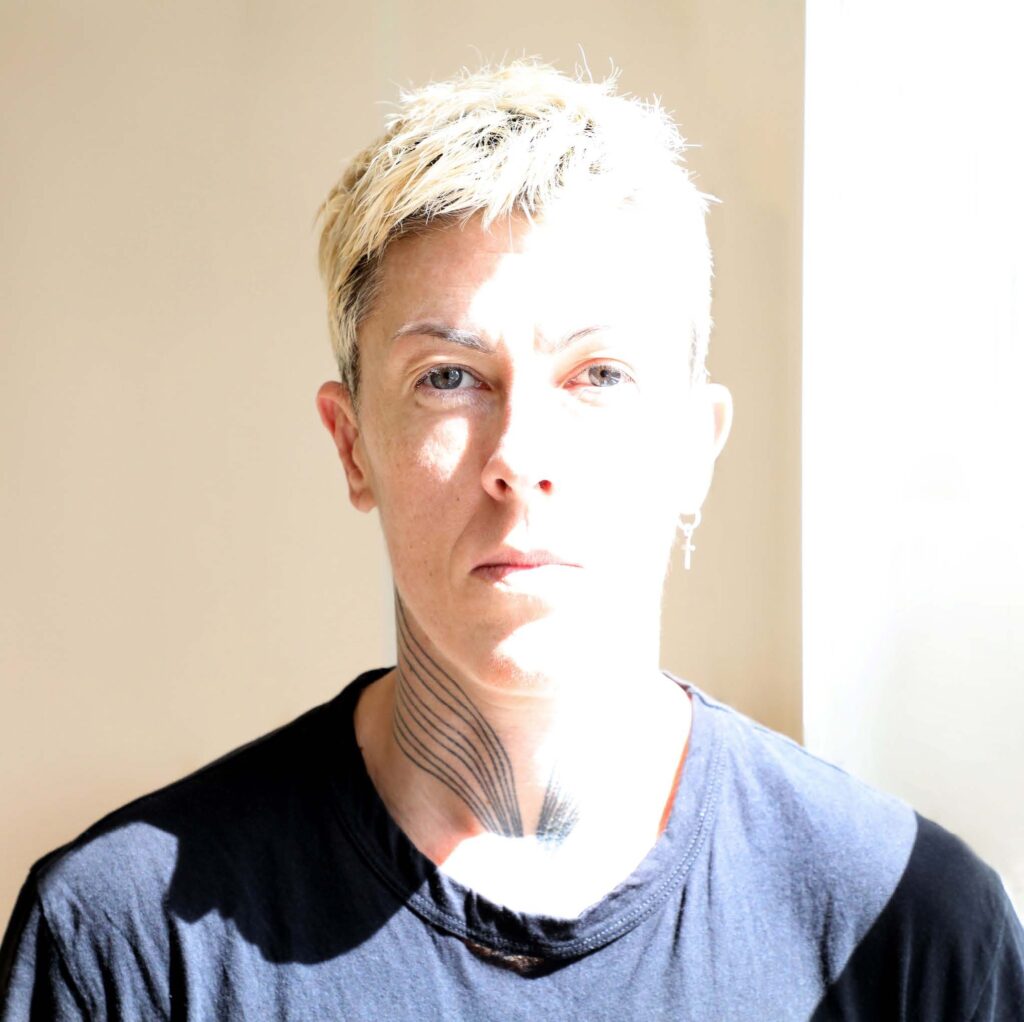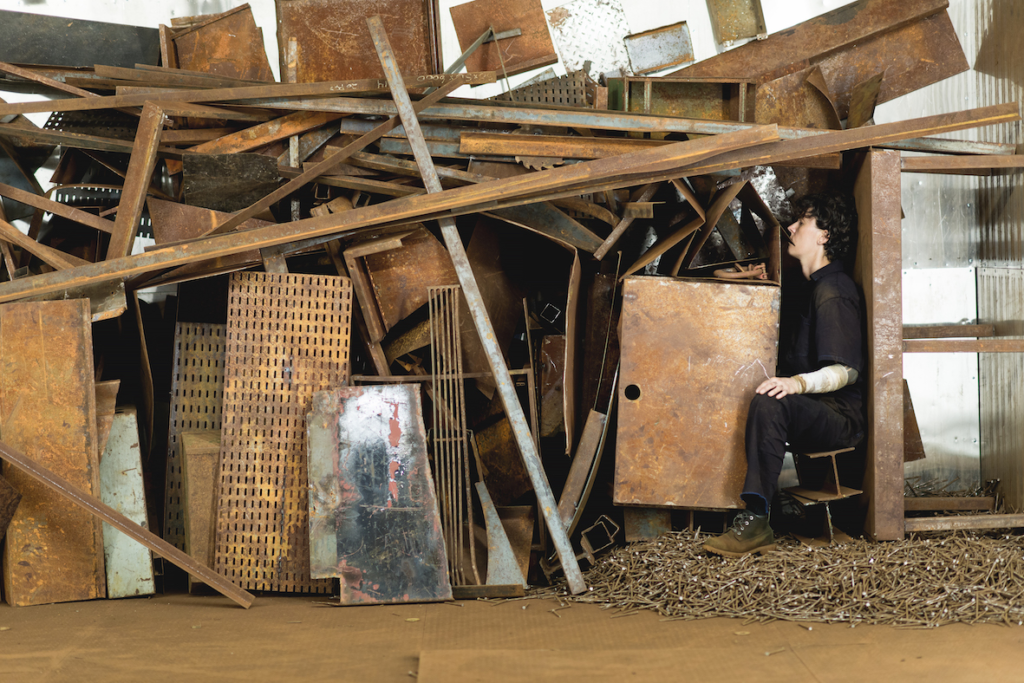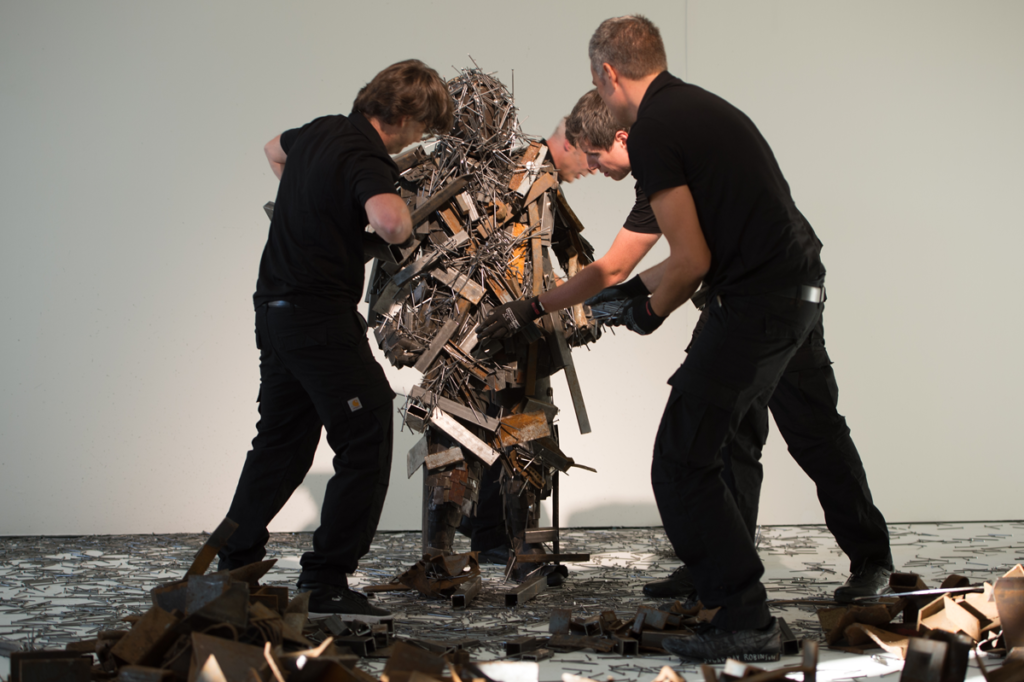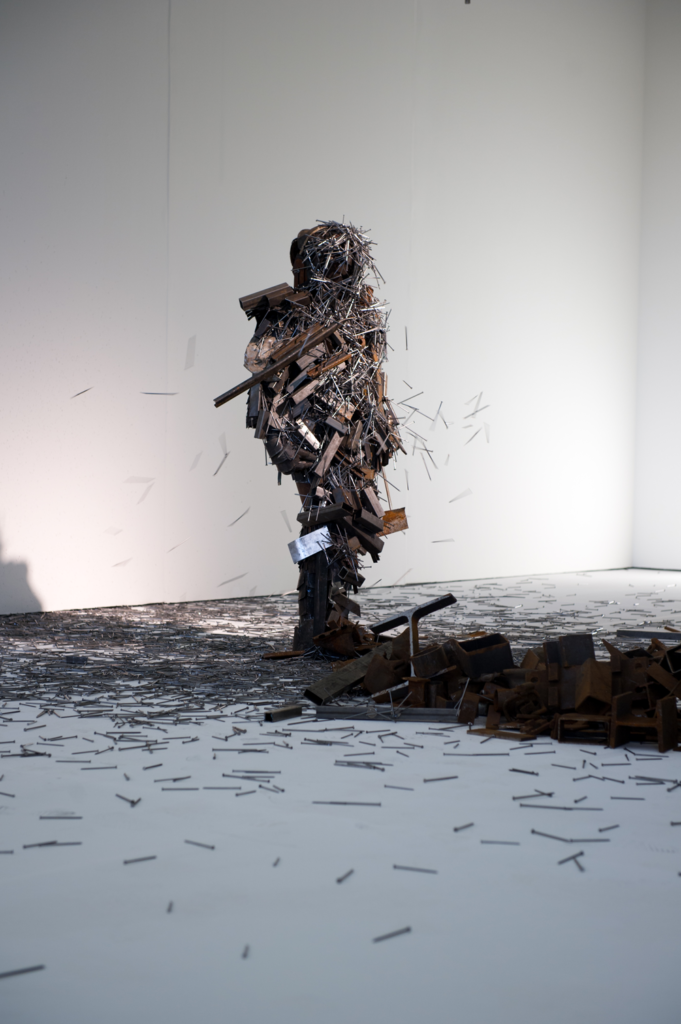Paula Garcia Dissects the Human Condition Through Performance, Reframing Perception With Visceral, Artist-Led Inquiry
Brazilian artist and curator Paula Garcia is renowned for her evocative experimental performance art that captures the raw essence of human existence beyond mere representation. Her work draws audiences into a realm where human immediacy is observed and deeply felt. At the heart of Garcia’s practice lies research and artistic experiences, with live art serving as the vessel of discourse.
She explores the production of performance projects from the perspective of an artist-driven process, seeking to unravel, dissect, and then weave again the threads of human perception and experience.

Photo Marco Anelli
My artistic projects have an experimental character, where I propose protocols that work with the issue of presence, sound and physical and mental limits
Paula Garcia
In recent years, Garcia’s research has led her to develop “Corpo Ruído,” or “Noise Body.” This practice involves manipulating sensory devices to destabilize the conventional understanding of the human body’s experience. By working with these devices, she generates distortions that challenge usual perceptions of an environment, offering alternative ways of experiencing it.
“Noise Body” represents a body defined by three key factors: precariousness, uncertainty, and risk. Garcia’s use of magnets serves as a means to discuss the invisible subjective forces and the more visible social forces that shape bodies, emotions, identities, and truths. In her performances, she aims to showcase bodies in disassembly and crumbling, using her body as a “material support” in which forms of conflict are inscribed.
In 2010, Garcia ventured into curation, melding her artistic sensibility with curatorial insights and forging collaborations with performance art titans such as Marina Abramović, Robert Wilson, Christine Mello, and Chuz Martinez, working in distinguished art spaces and events globally. This shift towards curatorial work allowed Garcia to present projects by artists within the performance domain, a field often marginalized within the art world.
By 2014, Garcia had become an associate curator for the Marina Abramović Institute (MAI). Through MAI, she co-curated and produced significant projects alongside Marina Abramović and a mosaic of international artists and curators. The result? A series of exhibitions underscored art’s potency as a performance, spanning cultural hubs like São Paulo, Athens, Bangkok, and Istanbul.
A bridge builder at heart, Garcia promoted dialogue and nurtured professional relationships among artists and curators. She remains committed to challenging traditional exhibition formats and facilitating artistic exchanges. Performance art, rooted in early 20th-century movements like Dadaism and Futurism, often captures raw, undiluted realism. It transcends mere representation, embodying expression in its purest form.
Garcia reflects this essence in her dual role as an artist and curator. We had the privilege to speak with Garcia to delve deeper into her practice and curatorial approach, setting the stage for a transformative experience this October as Marina Abramović and the Marina Abramović Institute’s (MAI) takeover of London’s iconic Southbank Centre.
Hi Paula, How are you doing? Thank you for taking the time to speak with us. Please tell us a little about yourself, your background and journey as an artist and curator, and what sparked your interest in art.
Paula Garcia: Hello, and thanks for the opportunity. My name is Paula Garcia. I am a queer artist and curator. I was born in São Paulo in 1975. At 18, I graduated as a professional actress. I worked as an actress in some projects until I was 24. But when I came into contact with works by artists such as Marina Abramovic, Yoko Ono, Nam June Pai, John Cage, Helio Oiticica, Lygia Clark, some examples, I decided to study performance.
I graduated with my undergraduate and master’s degrees in Visual Arts and am currently studying for my doctorate in São Paulo. Artistic production came first, and the curatorial practice began in 2010, when I started research to think about the production of performance projects, from the perspective of the artist-driven process. What interests me most in art is the urgency of producing an aesthetic discourse, which starts from our subjectivity so that we can discuss the present moment, in order to build new ideas of the world.

© Paula Garcia
Let’s start with your artistic practice, emphasizing research, live performance, and your embodiment within the artwork. Can you walk us through your inspiration and the creative process behind this approach?
Paula Garcia: It is important that we understand the historical contexts and bring into our practices the seed planted by the artists who came before us. I bring, somehow, in my practice, the work of these artists who preceded me, who are very powerful aesthetic discourses and who questioned and transcended the limits of art, both in artistic practice and in the relations of power that operate the art system.
My artistic projects have an experimental character, where I propose protocols that work with the issue of presence, sound and physical and mental limits. These are questions that exist in everyday life, at work, in affective relationships, and also in the political, social and cultural systems that operate in our society. I am interested in thinking through artistic and curatorial practice in performance, thoughts about the system that tries to transform everything into products, and thus, tries to transform aesthetic production into art, and also, the artist himself, into product. Therefore, my propositions want to bring to light these issues from experiences, that is, a phenomenon that is more difficult to control, package or sell. Thus creating a reversibility in the system, so that experience reveals these innards of power.
It is also crucial here how the body control systems and subjectivities are tools of this colonizing system of ideas and bodies. Drawing a parallel to thinking about the “molecular revolution” brought by author Suely Rolnik regarding the process of schizoanalysis, I research these confluent lines brought by the author and the processes of subjectivation and production of corporeities, based on this understanding that each gesture, each project are creations of these “gaps” that create these “cuts” and new folds are placed from these experiences in the production of radical corporeities.

Credit Hick Duarte
Shifting to your curatorial work, how, if at all, has your artistic practice informed and influenced your approach to curating?
Paula Garcia: My curatorial practice is also my artistic practice. I don’t separate one from the other. I say this because, in recent years, I have carried out some projects, culminating in the project with MAI in Amsterdam called No Intermission at the end of 2022. This last project is part of a curatorial concept that understands experience as an entity, a being, that brings together all aspects of these propositions – artist, spectator, time, space, light, odour, technicians, the surroundings of the space, the printed memory of what has already materialized in that space, the system of power that commands this space. In this way, all these layers form, as the author Leda Maria Martins brings us, a spiral of time where life is presented through an artistic work. All these pieces that make up the proposition matter; what is visible and invisible is revealed in the exchange between times of experience with the time of those who intend to be there.

Credit Erika Mayumi
Over the years, you have developed ‘Corpo Ruído (Noise Body)’, a practice that uses sensory devices to challenge traditional views of the body. In a series of performances, you use magnets and industrial iron scraps to express that the body represents a combination of vulnerability, unpredictability, and danger. Can you explain more about the core principles and significance of ‘Corpo Ruído’, specifically how the creative use of magnets helps to investigate the concept of forces?
Paula Garcia: Noise Body is part of a series of performances in which I cover my body with neodymium magnets, while collaborators cover these magnets with industrial pieces of iron until her body disappears under this rubbish and entire magnetized spaces where it performs within. The concept of “Body Noise” represents a body that is defined by the sum of three factors: precariousness, uncertainty and risk. Magnets are elements that serve to discuss the concept of forces.
Not just the invisible subjective type, but also the more evident type of social forces that work to consolidate a system of power that ends up shaping things like bodies, feelings, subjectivities and truths. In these performances, she tries to show disassembled bodies collapsing. Ultimately, what I propose in my actions is a performative use of my “body as a material support in which forms of conflict are inscribed”.
Are there recurring themes that intersect both your artistic and curatorial works?
Paula Garcia: Both practices deal with regimes of body presence in performance and the analysis of artistic and curatorial practices. It seeks relationships between body, performance and interdisciplinary curatorial propositions in the field of art. It observes how such relations behave as a field of forces both in the context of artistic production and in that of criticism and theory. It addresses communicational and historical processes, focusing on communications within the scope of ephemeral art, understanding it as a place of exchanges and dynamics of communication; it also seeks to problematize relations between artistic and media languages, bringing notes about different regimes and production of presence.
Lately, based on the concept of spiralling time by Leda Maria Martins, which emphasizes the coexistence of times, it is possible to analyze artistic and curatorial practices according to this epistemology that breaks the linearity of history and understands the past, present and future as simultaneous times.

My research also reflects on the notions of political body, performance, and public experience in ephemeral and participatory art projects as an artistic procedure, starting from the interrelationships and crossings between these terms to, thus, launch a thought about the states of presence of the body in contemporary artistic production. Nowadays, in my research, the theoretical foundation is based on reflections about the media launched by Vilém Flusser, in the philosophical issues related to contemporary body politics brought by Achille Mbembe, especially the notions of necropolitics and politics of enmity; in Suely Rolnik’s reflections that enter the micropolitical sphere and seek to understand the processes of oppression brought about by the colonial and capitalist system.
Which imprisons the vital force of the individual in the thinking of Angela Davis, who weaves her theories based on the intersectionality of race, gender and class; with regard to phenomenological studies and the production of presence, in the reflections of Hans Ulrich Gumbrecht and Paul B. Preciado, who present ways to escape the servitude of the binary regime of sexual difference. It is also important here how the body’s control systems and subjectivities are tools of this colonizing system of ideas and bodies.
How do you balance your individual voice as an artist with representing others in your curatorial projects?
Paula Garcia: As mentioned above, the two practices are interconnected; therefore, working with other artists is always connected to experimentation based on their artistic propositions. Working with other artists is a huge privilege and one that has sheltered me in a huge field of reflection and learning in the last few years. It is also interesting for the process as a curator in those projects because, as an artist, I have the same practice as them; this brings synergy to the conversations and ideas that they want to perform. In the last years, MAI has been growing a community of artists that work with performance that we want to expand and create activities with them for MAI in Keryes for the next year/s and decades.

In addition to your artistic pursuits and involvement in curatorial endeavours, you’ve been a long-time collaborator with MAI – Marina Abramovic Institute since 2012. Can you provide some insight into your collaborations and projects with MAI? What is it like working closely with Marina, and how did your association with MAI begin?
Paula Garcia: When I met Marina in São Paulo in 2010 via Luciana Brito, our gallerist, it was an event that has changed the course of my life ever since. In that first meeting, she told me about the MAI project, and I also had the opportunity to show her my work. I moved to New York in early 2012, where I stayed until the end of 2019 when we moved MAI operations to Greece. Since 2012, Marina has opened many opportunities for me to explore as an artist and curator. In 2015, I curated with Marina and performed in the Terra Comunal project in São Paulo at SESC Pompéia.
This project took three years to prepare, and Marina stayed in São Paulo for almost the entire two months of the project. When preparing the project, Marina said, “We are going to transform SESC Pompéia into a power plant,” which is precisely what happened. The MAI is part of Marina’s legacy, and MAI has learned a lot in each project and workshop that we carry out. We are a team of five: Marina Abramović, Thanos Argyropoulos, Serge Le Borgne, Paula Garcia and Billy Zhao.
MAI is now based in Keryes, the interior of Greece, where we started the first activities in the building this year with the House Cleaning Workshop. Beginning in 2024, we are planning to expand our schedule with activities focusing on different aspects of the process for producing performance. We are happy with this possibility.
This October, the Marina Abramović Institute will feature prominently at the Southbank Centre’s Queen Elizabeth Hall. As one of the highlighted performers, what can visitors anticipate from the experience?
Paula Garcia: We are very excited for the project at the Southbank Center. We have an amazing group of artists coming from different parts of the world that will bring powerful energy to the spaces. I think the public will have an opportunity to experience different formats of long durational performances with a variety of aesthetic discourses based on their research. Also, I would suggest the public stay for the whole time and see the works in different moments and have breaks, have a drink, smoke a cigarette and come back to watch again. Time here is what we also have to experience.
What advice would you give to young artists and curators starting in the field today?
Paula Garcia: Research, experiment and materialize your urgent discourses. The work will guide you for the next step.
What’s next for Paula Garcia?
Paula Garcia: I have a two month performance project, which is very challenging for me and for the institution that will host it.
Lastly, what does art mean to you?
Paula Garcia: Life.
©2023 Paula Garcia




